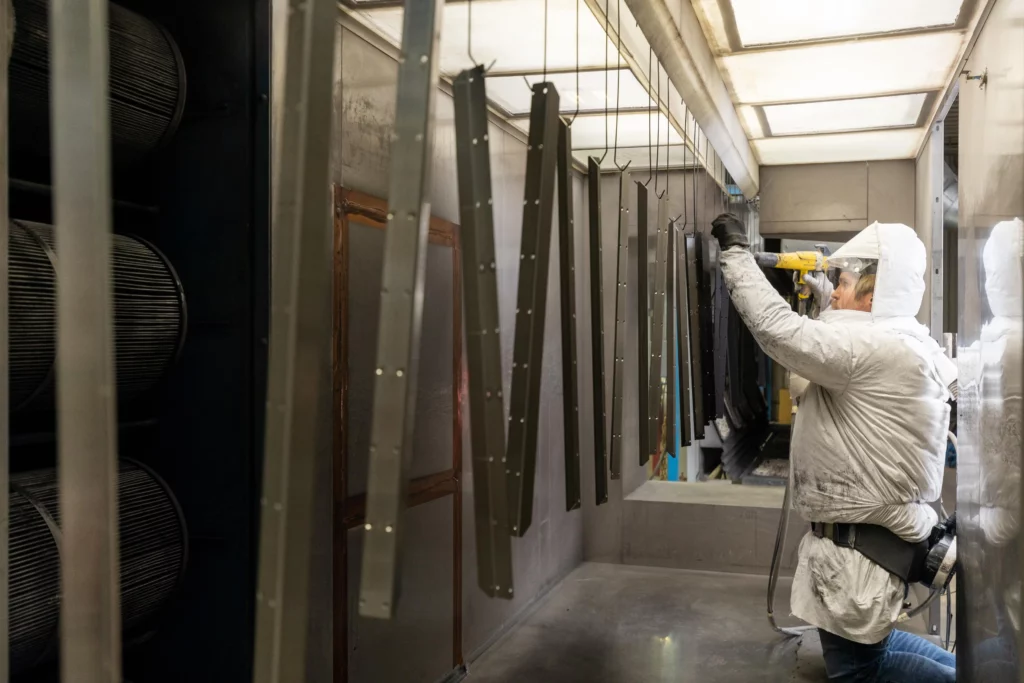Sheet Metal Pre-Treatment Process
At Midwest Metal Products, we’re meticulous in everything we do. This includes our consistent sheet metal pre-treatment process. For more than 50 years, our family-owned business has been a trusted single-source manufacturer for industries around the world. We’ve built a reputation as a preferred vendor in the aerospace, electronics, and medical equipment industries. Our clients rely on our quality processes and products.
Our Facility
We take care of you from start to finish. From our customer service to design to in-house screen printing, everything we produce is under one roof in Cedar Rapids. We provide innovative solutions, from concept to finished product. We’re proud to be the #1 custom sheet metal fabricator in the Midwest.
At Midwest Metal Products, we specialize in powder-coated sheet metal. Unlike traditional paint, powder coating does not require a solvent to keep the liquid in suspension. Without this liquid carrier, powder finish can produce much thicker coatings. With powder coatings, we can provide specialty finishes for our clients. We also like powder coatings because they’re better for the environment, as they release very few VOCs.
In theory, the process sounds very simple: We use an electrostatic method to apply dry powder. We then heat the metal substance to cure it. But at Midwest Metal, lots of additional quality steps go into the overall sheet metal pre-treatment process.
Before we powder coat anything, we have a strict pretreatment protocol and a detailed five-stage cleaning line. Because we have each of these steps segmented, you can expect consistent finishes on every part you order from us.
At Midwest Metal Products, we have more than 8,000 square feet of dedicated space in multiple facilities just for our powder coating process. We know that to get the best finishes, all metallic surfaces must be completely clean. A proper pre-treatment is essential for the adhesion of the powder or paint to the substrate.
Our Pre-Treatment Process
Here’s a quick look at our sheet metal pre-treatment process. All of our baths are on timers. This provides consistency and uniformity.
- Cleaning with alkaline (using Brulin 815 GD, the industry standard): This cleans virtually all types of metal, including steel, aluminum, and titanium. Proper cleaning removes all dirt, dust, machining oils, specks, and any foreign material.
- Overflowing free rinse. The water source is constantly regenerated to wash away all contaminants.
- Submerging in Isoprep 184. This process deoxidizes and activates the metal to accept the next treatment.
- Submerging rinse. This is a double rinse. We submerge the object and then hose it down with fresh water to remove any additional drag-out. This keeps our subsequent baths free of additional contaminants.
- Treating in chem-film: This step is used only for aluminum parts, not steel. We use three different processes, depending on your customer specifications:
- IRIDITE NCP produces a protective conversion coating and is a superior base coat for powder coating and is not affected by heat like other conversion coatings. It contains no chromium (hexavalent or trivalent), mercury or PBB/PBDE compounds.
- Clear 1500 can be used to create Class 3 coatings to follow military specs.
- Iridite 14-2, which has been the industry standard for years. In fact, 14-2 meets MIL-C-5541, contains self-healing properties, and serves as a good base coat for paint.
- Final rinse. This removes any unreacted agents and leaves behind a clean base coat.
- Forced air step. We use a drop line air nozzle to blow out the parts.
While some customers stop at this step, as all three can be a stand-alone finish, others request a finished coat.
Pre-Treatment for Steel Parts
Our steel parts are pretreated in a 5-stage automated system. Our line is gear-driven and digitally controlled for optimal exposure times. A radiant heat tunnel at the end expedites drying times. Our automated line includes the following steps:
- We begin by using Magnuspray, an alkaline cleaner. Magnum spray is used on many metal surfaces for a variety of applications.
- Then the metal goes through a forced rinse, using nozzles.
- Next, we apply a product called Securities. This is a phosphatized and rust inhibitor.
- We follow this with a second rinse, which removes reactants.
- For the final step, we use a product called SpectraLink, a sealer and adhesion promoter.
Using automatic conveyors and infrared ovens helps make the finishing process much faster, helping to boost productivity.
Once the components are dry from the pretreatment and cleaning stages, we complete the finishing steps for the metal parts. Depending on your preference, the pieces are either powder-coated, painted, or finished without any painting.
Powder-coating sheet metal provides a durable topcoat, provides a pleasing aesthetic appearance, and adds years to the surface life of a product. It drives down production costs because the powder coating process can take as little as 10 minutes in the oven. Powder-coated metal produces no chemical waste or harmful toxins.
The Midwest Metal Products Difference
As a NADCAP-certified facility, everything we do at Midwest Metal is driven by precision. We log each batch to keep our process consistent. In addition, we send out test samples each month to test for salt spray testing (ASTM B117) or fog testing.
This standardized test determines the corrosive effect of salt upon metal objects. Using a closed chamber, the test involves spraying the salt solution on a specimen. This accelerates the corrosion process that would occur in the natural environment.
We test each chem-film bath, as well as testing the adhesion of painted samples. This test tells us if our process is working correctly. The feedback we receive helps us continually improve our strategies.
Choose Midwest Metal Products as your single-source precision metal fabrication provider. We look forward to becoming your trusted source in the future.


